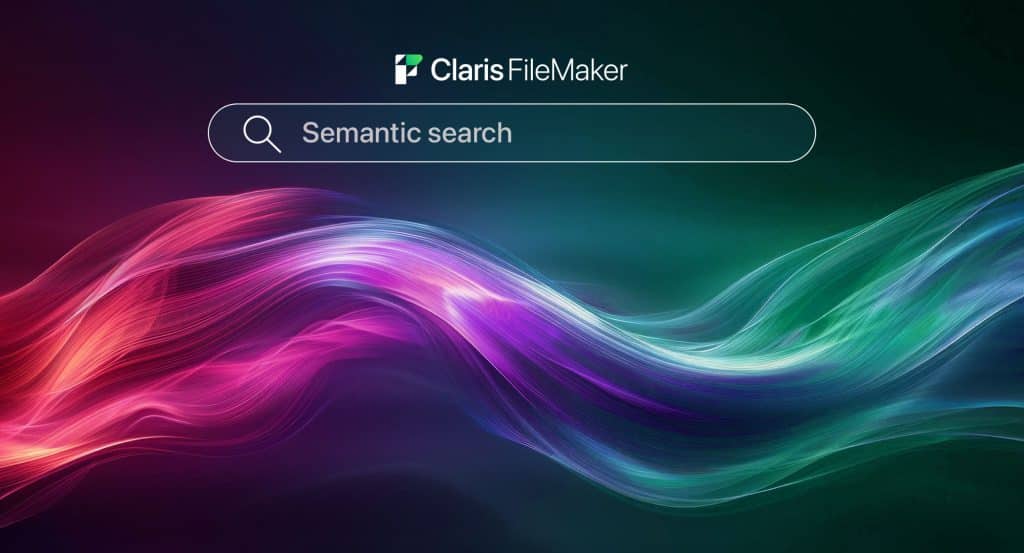What is semantic search and how to use it in Claris FileMaker.
Discover how AI-powered search elevates custom apps, enabling users to find information using everyday language.
Cathy
25 October 2024
•
 4
4
min
If you’re building apps or managing data with Claris FileMaker, you’re probably familiar with traditional keyword search, where users type in specific words to find what they are looking for.
With semantic search now available in Claris FileMaker 2024, you can provide your users with a smarter, more intuitive way to access information. This AI-powered feature transforms the search experience, allowing users to find what they need—even if they don’t know the right keywords.
Let’s explore semantic search, why it’s important, and how to enable it in FileMaker 2024.
List of topics in this blog:
- What is semantic search?
- Why is semantic search important for you as a developer?
- How semantic search works to provide deeper insights.
- How to enable semantic search in FileMaker 2024.
- Resources for mastering semantic search.
What is semantic search?
Traditional keyword search relies on exact matches to find relevant results.
In contrast, semantic search goes deeper by understanding the meaning and intent behind searches, offering better data retrieval with more accurate and context-aware responses.
In Claris FileMaker 2024, semantic search uses AI-driven natural language processing to analyze data contextually, delivering more relevant results.
For example, when you search for “best-performing sales reports,” semantic search doesn’t just look for documents with those exact words. It understands the intent and pulls up files that are semantically similar, like top sales summaries or performance reviews.
Why is semantic search important for you as a developer?
With vast amounts of data stored in systems, it can be challenging to sift through outdated or duplicate information. This can make data difficult to find and work with.
Semantic search cuts through the noise, allowing you to quickly find what you need by focusing on intent and context, rather than just keywords. Here’s why it’s a game-changer for your FileMaker apps:
Quicker insights.
Semantic search helps your user get to the most relevant information faster. Instead of relying on exact terms, it interprets intent.
For example, if a user searches for “customer feedback on recent updates,” semantic search will bring up reviews, support tickets, or user comments that discuss the updates—even if the exact phrase isn’t used. This saves time and effort, providing deeper insights more quickly.
Simplified user experience.
Today, people often spend a lot of time filtering through multiple spreadsheets or reports, trying to remember the exact file name or search term. With semantic search, they no longer need to worry about knowing the exact keywords or document titles.
For example, if a user searches for “quarterly performance overview,” instead of only returning files with that exact phrase, semantic search will intelligently pull up related documents like sales summaries, financial reports, or performance reviews—even if the titles and keywords differ. This makes finding the right information faster and more intuitive.
Enhanced decision-making.
Semantic search helps your users make informed decisions across any type of data, whether they’re working with product data, operational reports, or project tracking.
For example, if someone searches for “reasons for missed deadlines,” semantic search will surface insights from project timelines, meeting notes, and status reports—even if different terms like “delays,” “postponed tasks,” or “late completions” were used. This enables the user to quickly identify patterns and make better decisions without needing to know the exact phrasing.
Learn more: What you can do with semantic search.
How semantic search works to provide deeper insights.
For even deeper dives into data, semantic search can power retrieval-augmented generation (RAG). This technique combines context-aware content retrieval through semantic search with the generative abilities of large language models (LLMs), allowing you to generate content or summaries based on your existing data.
For instance, if a user searches for a “summary of quarterly performance issues,” your app can pull relevant details from various reports and then leverage an LLM to generate a concise overview, helping the user identify patterns and make decisions without having to sift through numerous documents.
How to enable semantic search in Claris FileMaker.
Implementing semantic search in Claris FileMaker is a straightforward process. Here’s how:
1. Upgrade to Claris FileMaker 2024.
Ensure you’re using the latest version of Claris FileMaker because you’ll need the new AI functionalities to add semantic search to your apps.
If you haven’t yet, upgrade now.
2. Use artificial intelligence script steps.
FileMaker 2024 introduces new script steps designed specifically for AI-powered functionalities like semantic search. Add these script steps into your workflows to enable semantic search.
These artificial intelligence script steps generate vector embeddings, allowing the search engine to process queries in a more context-aware manner.
3. Create vector embeddings for your data.
With the artificial intelligence script steps, you can create vector embeddings, which are mathematical representations of your data. These embeddings help the system understand the relationships between different data points, even if exact keyword matches aren’t present.
By doing this, your app can retrieve results based on meaning and context rather than just exact terms.
4. Test and fine-tune queries.
Once you enable semantic search, test search queries like “best-performing sales reports” to verify that the search engine can interpret this intent and return results that include sales summaries, performance reviews, and related documents.
5. Leverage contextual understanding.
One of the most powerful features of semantic search is its ability to understand natural language queries and the relationships between different concepts.
Design your workflows to focus on user intent, using natural language queries and relationships between concepts to deliver better results.
By following these steps, you can enable semantic search within your FileMaker apps, providing users with a more dynamic and intelligent search experience that goes beyond traditional keyword-based methods.
Have a question or need help? Get assistance in Claris Community.
Resources for mastering semantic search.
Ready to dive deeper into semantic search? Here are some excellent learning resources:
Let’s get FileMaker 2024 in your hands.
Now’s the time to integrate semantic search, so your users can enjoy a seamless, AI-powered search that feels modern, natural, and productive.
Upgrade to FileMaker 2024 and get started today.



